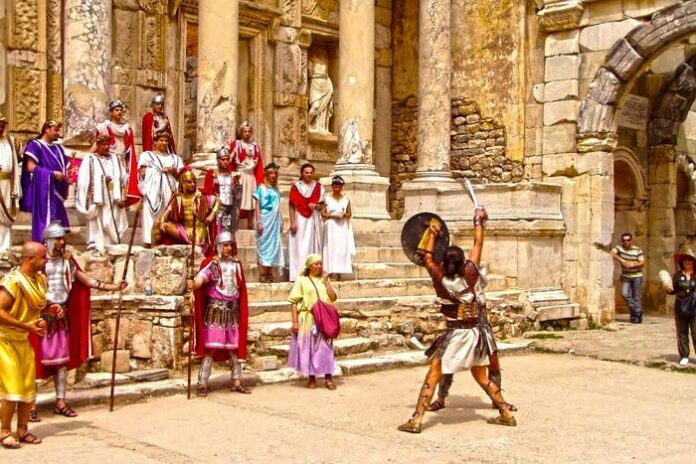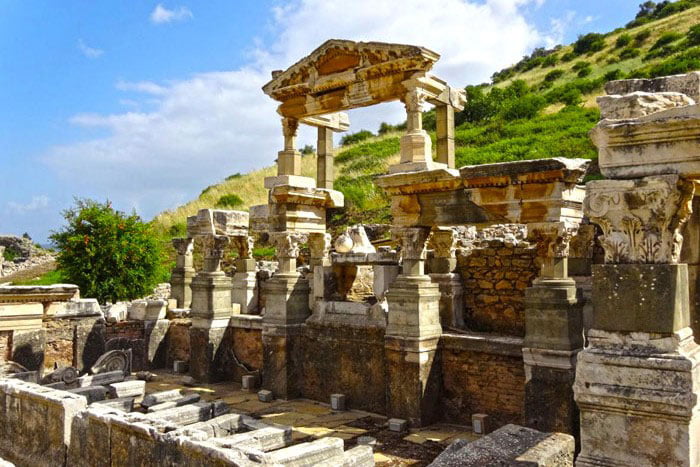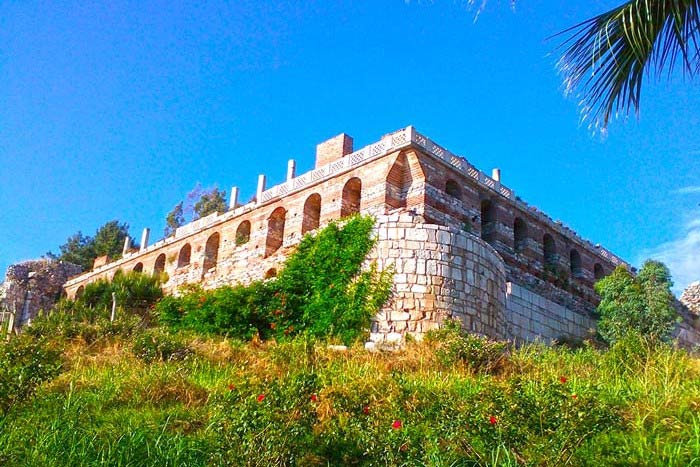Ephesus Guides: Discovering the Roman Population of Ephesus
Introduction to Ephesus and Its Importance
Ephesus was once called Lumen Asiae, which means The Light of Asia. It was a powerful city in ancient times. The city had a key role in trade and religion. It was the most important city in the Roman province of Asia.
In the Roman era, Ephesus became a leading religious center. The people worshipped the mother goddess. It was also the fourth-largest city in the world after Rome, Alexandria, and Antioch. Our tour guide Ephesus can show you more.
Was Ephesus Really That Big?
For many years, historians believed Ephesus had 225,000 to 300,000 people. This number seemed very high. It would mean Ephesus had a very dense population, like modern cities.
But new studies say this number was likely too large. Ephesus had mountains, sea, and stone quarries nearby. These made it hard to build large homes outside the city walls.
The city’s size was limited by its location. The area inside the walls could only hold so many people. That is why newer estimates are lower.
Ephesus Guides and the Lysimachus Wall
The wall built by Lysimachus is still a major part of the city’s ruins. This wall enclosed Ephesus to protect it. The area inside the wall was around 415 hectares (or 1,030 acres). This area included not only homes but also public spaces.
Many places inside the wall were not used for housing. There were wide roads, markets, temples, and government buildings. Also, Bulbul Mountain, inside the city, was steep and hard to build on. So people could not live on that mountain easily.
If you’re interested in Roman city planning, private guide Turkey can explain it all during your tour.
Realistic Population Estimates
A scholar named Jerome Murphy-O’Connor gave a more detailed estimate. He believed about 345 hectares of the city were used for housing. He used a population density of 400 to 500 people per hectare.
With that, he estimated 138,000 to 172,500 people lived in Ephesus. He believed the higher number was closer to the truth.
Another expert, J. W. Hanson, had a different view. He said only 224 hectares were used for homes. He believed fewer people lived in each hectare. His estimate was 33,600 to 56,000 people.
These are lower numbers, but still large for the ancient world. With even the smallest estimate, Ephesus was one of the top cities in Asia Minor.
Ephesus Compared to Other Ancient Cities
Even if we take the lowest number—around 33,000—Ephesus was still a major urban center. Only Sardis and Alexandria Troas were possibly larger in Roman Asia Minor.
This makes Ephesus a top destination for Roman history fans. Join our tour packages Balkan for a wider view of the Roman world. We also offer regional tours that connect cities like Ephesus and Troas.
The Role of the Grand Theater in Estimating Population
Some estimates of the population are based on the Grand Theater. The theater could hold up to 25,000 people. That gives an idea of how many people lived in the city.
Not all citizens went to the theater at the same time. But a large theater means a large city. Theaters were important in Roman life. They were used for shows, speeches, and meetings.
This is one way experts try to understand how big ancient cities really were. Our ephesus guides explain these sites in detail.
Other Clues About Population Size
Population estimates are based on many clues. Scholars use maps, ruins, written records, and sizes of public spaces.
Coins, tombs, and house sizes give more information. These items show how people lived. Wealth, social class, and family size can all affect how many lived in one home.
Archaeology shows that Ephesus had both rich and poor areas. Big homes and simple houses were found side by side.
Why Population Size Matters
Knowing the population helps us understand how advanced Ephesus was. A city with over 100,000 people needed water systems, waste removal, and food markets.
They also needed guards, teachers, priests, and builders. Ephesus had all of these. That means it was well-organized and powerful.
The more we learn about its people, the better we understand Roman life. Ask your tour guide Ephesus about these topics during your visit.
Modern-Day Visits with Ephesus Guides
Today, the ruins of Ephesus are one of the top tourist spots in Turkey. Many visitors come every year. The theater, Library of Celsus, and the Temple of Artemis are key highlights.
With expert ephesus guides, the stones and ruins come alive. You can walk the ancient roads where Roman citizens once walked.
Whether you are a history lover or a casual traveler, you will enjoy learning about the city’s population and past.
Plan Your Visit with a Private Guide
It is easy to plan your Ephesus trip. You can choose a private guide Turkey for a custom experience. Or, join a group tour with travelers from around the world.
Need more travel options? Try our tour packages Balkan for a wider journey across historic sites.
If you have any questions or need help, feel free to contact us. We are happy to help you plan a perfect visit.
Final Thoughts
Ephesus was one of the largest cities in Roman Asia Minor. Even with new studies lowering the population estimate, its size and role were impressive.
Thanks to archaeologists and historians, we now have better tools to understand ancient cities. Ephesus offers a rich story through its ruins and remains.
Use professional ephesus guides to get the full picture. Explore the Roman world, one step at a time.




